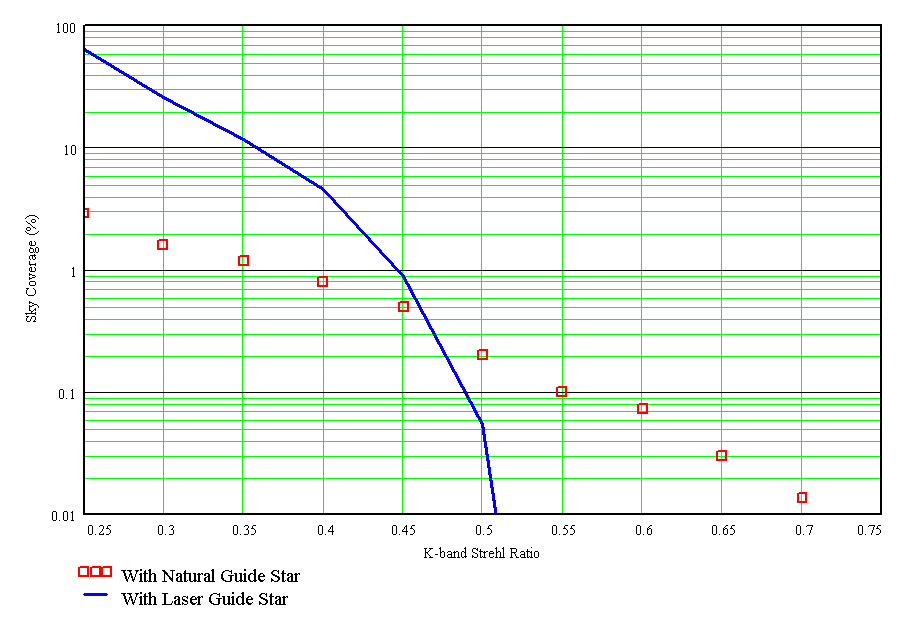Laser Guide Star for Adaptive Optics
Laser Guide Stars (LGS) are artificial sources, potentially replacing Natural Guide Stars (NGS) as reference objects for Adaptive Optics (AO) image corrections. LGS projectors have been used on a number of 4m-class telescopes and are basically part of every 8-10 m-class project. This includes the VLT with the current UT4 (YEPUN) sodium LGS development. The rationale is the much higher sky coverage offered in principle by an LGS, as opposed to the standard NGS approach, as can be seen from the set of two curves below. Due to the bright (m ~ 10) artificial star created near the centre of the field, the probability to achieve a given minimum AO correction on an arbitrary astronomical target, goes e.g. from a meager 3% with an NGS to 65% with an LGS, for corrected images with at least a 25% K-band Strehl ratio (defined as the ratio between the peak intensity of the corrected image to that of a purely diffraction-limited one).
A (possibly fainter/farther from the centre of the field) NGS is still needed to correct stellar agitation (tip/tilt), since it cannot be sensed from the LGS; this is why sky coverage cannot go up to 100% and decreases with higher Strehl ratio (better image correction). Note also that, contrary to the case of NGS-only AO, LGS-based corrections saturate at a relatively low maximum K-band Strehl ratio of ~ 0.55: this is due to the finite altitude (~90 km) of the Earth sodium layer and hence of the artificial star (the so-called cone effect).
Both NACO and SINFONI are developed to work either in the pure NGS mode, for best correction when a bright nearby star is available, or in this combined LGS/NGS mode, to get extended sky coverage, in particular for extragalactic observations.
The current PARSEC project is based on a 4W CW Sodium Laser (589 nm), focused at 90 km altitude in the mesosphere via a dedicated 50 cm diameter launch telescope. A thin layer of atomic sodium is present at that height, which backscatters the spot image and produces an mV ~ 10 artificial star to guide the AO servo loop.
The laser is hosted in a dedicated laboratory under the Nasmyth platform of UT4 which has been already installed. A custom-made single mode fibre carries the high laser power to a launch telescope situated on top of the secondary mirror assembly, providing the best possible artificial source image quality. As a safety measure, a twin whole-sky camera with specialized software is used to monitor incoming aircraft and shut down the beam accordingly.
The PARSEC development is actively pursued and first artificial light over Paranal is expected in early 2004, hopefully soon followed by the first corrected images.
On a longer term, ESO is studying innovative technologies for the LGSF in collaboration with MPE-Garching and industry. Two crucial areas are explored: innovative, high-efficiency lasers, and high laser power fibre propagation. Such advanced techniques are needed for the next generation of Multi-Conjugate Adaptive Optics (MCAO) with multiple lasers, in particular to achieve sub-0�.1 image quality at optical wavelengths and in sizeable fields (1 arcmin. on the sky or more).

The figure shows the cumulative sky coverage as a function of K-band Strehl ratio (from analytical computations):
- mean Paranal atmospheric parameters (0.66" FWHM seeing & 6 ms correlation time; 0.4 Strehl anisoplanatism contribution at 20" elongation; all these values at a wavelength of 0.50 µm
- Sodium LGS (m~10; 1" FWHM spot)
- AO system (80 corrected modes)
Note that these curves change dramatically for different atmospheric parameters and different wavelengths.
